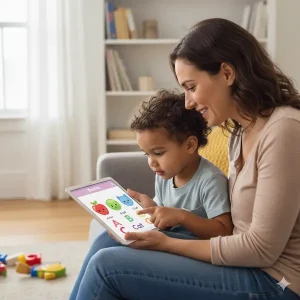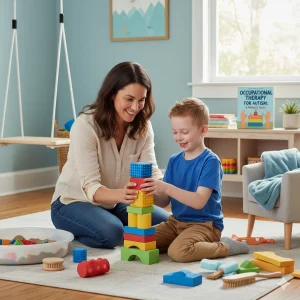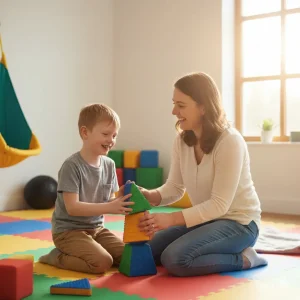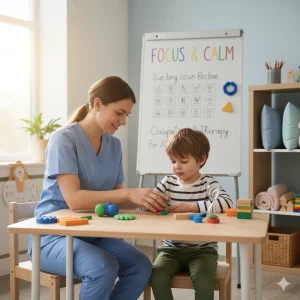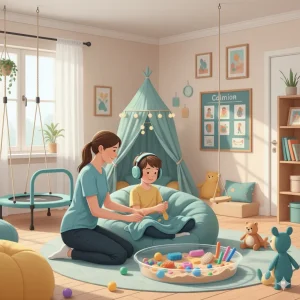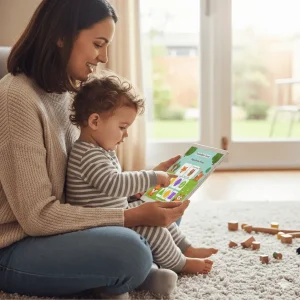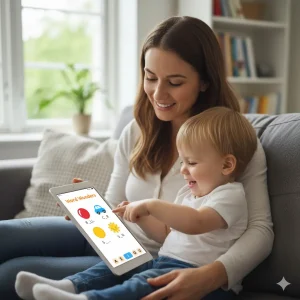Support Speech Development at Home With BASICS App
By Wellness Hub
Last Updated: July 23, 2025
Is your child struggling to say their first words or express themselves clearly? You’re not alone—and the good news is, you can make a big difference right at home. Early speech and language development is crucial for building confidence, learning, and social interaction. Whether your child has a speech delay, autism, or just needs a little extra support, there are powerful, therapist-approved strategies you can use every day. In this guide, you’ll discover how to support your child’s speech development at home using simple routines and the trusted BASICS speech and autism therapy app—a favorite among parents and professionals alike. From fun speech therapy exercises to interactive app-based adventures, get ready to turn your home into a hub of communication and growth.
Why Early Speech and Language Development Matters
From a child’s first coos to their first full sentences, speech and language development is a foundational part of growing up. It’s how children learn to connect with others, express their needs, and make sense of the world around them. But when a child doesn’t reach these milestones at the expected time, it can be worrying for parents—and for good reason.
Understanding Speech Delay in Toddlers and Preschoolers
Every child develops at their own pace, but certain signs—like not babbling by 12 months, not using words by 18 months, or not combining two words by age two—can point to a speech delay. In toddlers and preschoolers, delayed speech might show up as limited vocabulary, unclear pronunciation, or difficulty following simple directions. While it can feel overwhelming, the important thing to know is that you’re not alone—and there’s a lot you can do to help.
Early speech therapy for toddlers can be a game changer. The earlier a delay is identified and supported, the better the outcomes for a child’s overall development. That’s because speech and language skills are closely tied to cognitive growth, emotional regulation, and even academic performance. When a child can’t communicate effectively, it can affect everything from making friends to participating in school activities.
The Power of Early Speech Therapy
Early speech therapy helps children build strong communication skills before they reach school age, when language demands increase dramatically. Whether working with a professional or using tools at home, consistent support gives children the chance to practice sounds, learn new words, and improve understanding. Even daily activities—like naming fruits while grocery shopping or talking through a bedtime story—can support healthy speech and language development.
Technology has also made speech support more accessible than ever. For example, parent-friendly apps like BASICS offer interactive activities designed by speech therapists to nurture language growth in children ages 2 to 8. These tools are especially helpful for families managing speech delays or looking to supplement formal therapy.
Signs Your Child May Need Speech Support
As parents, we all look forward to hearing our child’s first words, that joyful “mama” or “dada” that makes your heart melt. But what happens when those words don’t come as expected? While every child develops at their own pace, knowing the early speech therapy signs can help you take timely action if something feels off.
Common Signs of Speech Delay in Children
Some kids start talking late and quickly catch up—but others may need a little extra help. Below are some common signs that your child may need speech support:
- Limited vocabulary for their age
If your toddler isn’t using at least 50 words by age two, it may be a red flag for a language delay. - Unclear or hard-to-understand speech
Strangers should be able to understand most of what your child says by age three. If not, it may point to issues with sound production or autism speech development patterns. - Trouble forming sentences or combining words
By age two to three, most children begin combining two or more words (“want juice,” “go park”). Difficulty doing this might signal a speech delay in children. - Lack of interest in communication
Not responding to their name, avoiding eye contact, or showing little interest in social interaction may be more than just a quiet personality—it could be connected to autism spectrum communication differences. - Difficulty answering simple questions
If your child struggles to answer “what” or “where” questions, or seems confused by common requests, they may be having trouble processing and using language.
When to Consider a Speech Therapy App or Professional Help
If you’re noticing one or more of these signs, the first step is to observe your child over a few weeks. Sometimes, small delays catch up naturally. But if the gap seems to widen—or if your child becomes frustrated trying to communicate—it may be time to seek support.
You don’t need to wait for a diagnosis to take action. Many parents now turn to speech therapy apps as a gentle, engaging way to support their child’s communication skills at home. Tools like the BASICS app are designed by speech therapists to offer structured, play-based activities for children with language delays, speech challenges, or autism speech development needs.
Of course, if you’re seriously concerned or feel unsure, it’s always wise to consult a pediatrician or licensed speech-language pathologist. A professional can help assess your child’s needs and guide you toward the right plan—whether that includes formal therapy, home-based practice, or both.
5 Therapist-Backed Speech Therapy Activities at Home
You don’t need a classroom or clinic to help your child grow their communication skills. In fact, your home is one of the best places for speech and language development—and daily routines offer tons of built-in opportunities to support learning in fun and meaningful ways.
Speech therapists often emphasize that consistency and connection are more powerful than perfection. So, here are 5 simple, therapist-recommended speech therapy activities you can do right at home—with no fancy materials required.
1. Talk Through Mealtime
Mealtime is a language goldmine. As you prepare and serve food, name items out loud: “banana,” “spoon,” “hot soup.” Use action words like “cut,” “pour,” or “eat.” Give your child choices: “Do you want an apple or a banana?” Encouraging them to respond builds vocabulary and sentence structure naturally.
Bonus Tip: If your child has a speech delay, focus on modeling simple, clear phrases. Repeat and expand: If they say “juice,” you say, “Want juice?” or “Juice, please.”
2. Story Time With a Twist
Reading is a classic way to support speech therapy for toddlers. But it’s not just about the words on the page—how you read makes all the difference. Ask questions, point to pictures, and pause to let your child describe what they see.
Try interactive books with textures or flaps. For children with language delay, repetition helps—read the same story several times across a week to reinforce understanding and recall.
Speech Therapy Sign: If your child struggles to answer “What is this?” or “Where is the dog?” during story time, it may signal a delay in expressive or receptive language.
3. Play Pretend and Narrate Everything
Pretend play builds imagination and communication. When you play with toy animals, cars, or a pretend kitchen, describe everything as if you’re commentating: “The cow says moo!” or “We’re cooking pasta. Stir, stir!”
Invite your child to take the lead and follow their cues. If they say “drive car,” you can expand with “Yes, the red car is going fast!”
This technique, known as parallel talk and expansion, is widely used in early speech therapy.
4. Sing Songs With Repetition and Movement
Songs like “Old MacDonald,” “Wheels on the Bus,” or “Head, Shoulders, Knees, and Toes” are amazing tools for speech development. Why? They involve repetition, rhythm, and gesture—all of which help children connect sounds with meaning.
Even children with autism speech development challenges often respond positively to music. Add hand motions or visuals to keep them engaged.
5. Use a Speech Therapy App for Structured Practice
Sometimes, you need extra support—and that’s where a speech therapy app like BASICS comes in. Designed by certified therapists, the app offers engaging, story-based activities that align with your child’s current skill level. Whether you’re working on first words, WH questions, or sound articulation, it turns home time into therapy time—with zero pressure.
Apps can help children with speech delays or those on the autism spectrum practice skills daily in a fun, non-clinical way. Parents can track progress and tailor content to their child’s needs.
Using the BASICS App for Speech and Language Development
Supporting your child’s communication doesn’t have to be overwhelming—or expensive. With the right tools, parents can bring expert-designed learning right into the living room. One such tool making waves among families and therapists alike is the BASICS app, a powerful, play-based platform that makes speech therapy at home both structured and fun.
What is the BASICS App?
The BASICS app is a holistic, evidence-based learning tool designed by a team of speech therapists, occupational therapists, behavioral experts, and special educators. With over 7 lakh installs and recognized as Google’s Best App for Good 2023, it’s quickly become one of the best speech therapy apps available for children aged 2 to 8.
At its core, BASICS is more than just a learning app—it’s a digital therapy companion built to support speech, language, emotional, and cognitive development, especially for children with autism, ADHD, speech delays, and other learning differences.
How the App Supports Speech Therapy at Home
What sets BASICS apart is its structured yet flexible design, tailored to how children learn best—through stories, play, and repetition. The app offers two distinct modes:
Goal Mode (Therapist-Guided)
This mode follows a developmental pathway created by speech and language experts. Parents can choose specific goals like:
- “Learning First Words”
- “Answering WH Questions”
- “Building 2–3 Word Phrases”
Each goal includes 100–120 interactive Sets, grouped into Chapters and wrapped inside story-based Adventures—like feeding a hungry mammoth or crossing a bridge with a dinosaur. These adventures create a sense of progress and excitement while reinforcing therapeutic goals.
This structure is especially effective for children with speech delays or those who benefit from consistent, guided repetition—like children on the autism spectrum.
Library Mode (Free Exploration)
For more flexible use, this mode allows children, parents, or therapists to browse content freely by:
- Level (from beginner to advanced)
- Group (thematic categories)
- Skill Type (speech sounds, vocabulary, emotions, sentence building, and more)
This makes it ideal for targeted practice during therapy sessions or child-led learning at home.
Why It’s a Great App for Autistic Children
Children on the autism spectrum often face unique communication challenges. The BASICS app is thoughtfully designed to support these needs with:
- Visual learning through animations and video modeling
- Predictable routines and repeatable language cues
- Interactive stories that teach both speech and social-emotional skills
- Gentle, sensory-friendly interfaces
This makes it one of the most effective apps for autistic children, as it allows them to learn in a low-pressure, engaging environment tailored to their pace.
Is BASICS the Best Speech Therapy App for Your Child?
If you’re a parent looking to support your child’s speech and language development at home—without having to guess what works—the answer may very well be yes. The BASICS app doesn’t just entertain; it educates with purpose. Whether you’re working on early speech sounds, building vocabulary, or preparing your child for real-life conversations, BASICS provides expert-level guidance right from your phone or tablet.
Key Features of the BASICS App
The BASICS app isn’t just another educational tool—it’s a thoughtfully designed speech therapy app for kids, created by experts who understand how children learn best: through play, structure, and repetition. Whether your child is just beginning to speak or needs help forming full sentences, BASICS offers the right tools to build those essential skills—step by step.
Let’s take a closer look at the features that make BASICS so effective for speech and language development.
1. Structured Goal Mode: Therapist-Guided Learning
The Goal Mode in the BASICS app offers a clear, step-by-step path that supports your child’s communication growth. Each goal—like Learning First Words, Answering WH Questions, or Building Simple Sentences—is broken down into bite-sized learning units called Sets. These Sets are grouped into Chapters, each wrapped in a fun, animated story.
This mode is perfect for parents who want a roadmap, especially if your child has a speech delay or specific learning needs. As your child progresses through the Sets, they’re gently guided toward developmental milestones in a way that feels like play—but is actually based on solid therapy techniques.
Best for: Consistent, goal-based practice. Great for kids with speech delays or those needing structured support.
2. Flexible Library Mode: Explore at Your Own Pace
Prefer a more relaxed, choose-your-own-adventure approach? Library Mode lets you explore the entire content catalog based on:
- Skill level (from early learners to advanced speakers)
- Skill type (like vocabulary, speech sounds, or emotions)
- Category (e.g., food, animals, actions)
This mode is ideal for child-led learning, therapy sessions, or targeting specific areas where your child needs extra practice. For example, if your child is working on saying the /s/ sound, you can jump right into that sound group.
3. Speech Sound Practice and Articulation
The BASICS app includes an entire level focused on speech sound practice, helping kids master tricky sounds like /p/, /s/, /k/, and more in the beginning, middle, and end of words. Each sound is paired with images, voice cues, and repetition—making it easy for children to hear, see, and say the correct sound.
This feature is incredibly helpful for children with articulation challenges, and it’s what makes BASICS stand out as a go-to speech practice app.
4. Vocabulary Building for Everyday Communication
Strong vocabulary is the foundation of clear communication—and the BASICS app makes it fun and interactive. Through colorful visuals and themed Sets, your child can explore words related to:
- Animals
- Emotions
- Body parts
- Household objects
- Food and actions
Whether your child is just starting to label items or is building longer phrases, BASICS works as a vocabulary app for children that grows with them.
5. WH Questions: Practice Understanding and Responding
Answering WH questions—like “what,” “where,” “who,” and “why”—is a key part of language comprehension. BASICS has an entire level dedicated to these skills, using picture-based prompts and engaging scenarios to help children practice understanding and responding.
This feature is especially beneficial for children with autism, language delays, or difficulties with social communication.
6. Interactive Adventures That Motivate and Reward
Kids don’t just complete tasks—they go on adventures. Each learning journey in Goal Mode is wrapped inside an animated story. Your child might:
- Feed a hungry mammoth
- Help a dino cross a bridge
- Build a rainbow salad
- Track feelings with a friendly dodo
These interactive Adventures make learning fun and rewarding, increasing motivation and helping children stay engaged through repetition and visual storytelling.
How the BASICS App Supports Children with Autism and ADHD
Children with autism and ADHD often experience unique challenges when it comes to speech, language, behavior, and attention. Traditional learning environments might not always meet their needs—but that’s where the BASICS app truly stands out. Thoughtfully designed with the input of speech therapists, occupational therapists, and special educators, it functions as a powerful autism therapy app and learning companion for neurodivergent children.
Custom Goals for Autistic Children and Attention Challenges
One of the most valuable features of the BASICS app is its Goal Mode, which allows parents and therapists to choose specific developmental paths tailored to a child’s individual needs. For example, parents of autistic children can select goals such as:
- Learning first words
- Understanding emotions
- Answering WH questions
- Practicing turn-taking and greetings
These custom goals are broken into manageable steps, making it easier for children with limited attention spans or sensory sensitivities to learn at their own pace.
Children with ADHD often need short, focused activities with clear structure and immediate rewards. BASICS provides just that—through short Sets, visual instructions, and motivating Adventures that keep kids engaged without overwhelming them.
Whether your child is on the autism spectrum or managing ADHD, BASICS gives them a sense of progress and success with every tap.
Benefits of Autism-Friendly Design
As an autism learning app, BASICS incorporates several design elements that align with the learning styles of neurodivergent children:
- Visual-first content: Colorful animations, pictures, and video modeling reduce reliance on complex verbal instructions.
- Consistent routines: Each activity follows a predictable pattern, which is comforting and calming for many autistic children.
- Minimal distractions: The app avoids sensory overload by using clean layouts, soft transitions, and clear audio.
- Repetition and reinforcement: Repeating activities helps children with autism or ADHD strengthen neural pathways related to speech and comprehension.
Because it’s not just about speaking—it’s about understanding, processing, and connecting—BASICS creates a space where communication can flourish naturally.
A Therapy Companion, Not Just a Learning App
Unlike generic educational games, the BASICS app is built specifically as an autism therapy app. It supports behavior and emotional regulation alongside speech. For instance:
- Children track emotions with story characters like Daisy the Dodo 🦤
- Social stories help explain routines like brushing teeth, visiting the doctor, or going to school
- Interactive activities help build self-regulation, patience, and communication
For children who struggle with transitions, sensory processing, or social skills, these features make learning both accessible and meaningful.
Support for Parents, Too
Caring for a child with autism or ADHD often means playing the role of parent, advocate, and teacher all at once. BASICS helps ease that burden by offering:
- Built-in caregiver guidance
- Printable resources like emotion charts, speech flashcards, and daily routine boards
- Therapist-created videos on topics like behavior management and emotional development
This makes BASICS not just an app for autistic children, but a true support system for families navigating developmental challenges.
Tips for Parents Supporting Speech Development at Home
As a parent, you play the most important role in your child’s communication journey. While speech therapists offer guidance and expertise, it’s the daily interactions at home that create the strongest foundation for lasting progress. The good news? You don’t need to be a professional to make a real impact. With a few simple tools and strategies, you can support your child’s speech and language therapy at home—naturally and effectively.
1. Be Consistent With Practice
Just like learning to walk or ride a bike, speech development takes practice—and the more consistent you are, the better the results. Short, daily interactions are more effective than long, occasional sessions.
- Use the same words or phrases often.
- Repeat and expand on what your child says.
Example: If your toddler says “car,” you say, “Yes! A red car is going fast!” - Make speech time part of your routine—during meals, bath time, or playtime.
This kind of repetition helps toddlers make connections between objects, actions, and words, which is essential in teaching first words.
2. Use Visual Tools Like Flashcards and Printables
Children, especially toddlers, are visual learners. Using speech therapy flashcards can help build vocabulary, improve memory, and support sound recognition. The BASICS app includes a wide range of printable speech therapy resources, such as:
- WH-question packs
- Emotion charts
- Object and action flashcards
- Sentence builders
- First words posters
You can print these out and place them around your home—on the fridge, toy box, or bathroom mirror—to reinforce language all day long.
Flashcards are especially helpful for kids with speech delays or limited verbal output, as they provide clear, focused visuals to support word learning.
3. Create a Language-Rich Environment
Children learn best in environments where words are everywhere. The goal is to immerse your child in language throughout the day in a way that feels natural—not forced.
Here’s how:
- Narrate your actions: “Mommy is washing the dishes,” “You’re putting on your shoes.”
- Ask open-ended questions: “What do you see outside?” or “How did that feel?”
- Label everything: From furniture to food, naming objects helps expand vocabulary.
Turn ordinary moments into learning opportunities. A walk in the park becomes a chance to identify birds, trees, and colors. A trip to the grocery store is perfect for speech therapy for toddlers—name fruits, count items, or describe actions like “pushing,” “grabbing,” or “buying.”
4. Use Apps and Games to Reinforce Learning
Interactive tools like the BASICS app make speech practice exciting. From teaching early vocabulary to building simple sentences and answering WH questions, BASICS turns daily learning into a playful experience. Use it alongside your flashcards and conversations for a well-rounded approach to speech and language therapy at home.
5. Celebrate Every Small Win
Progress in speech therapy takes time, and every child develops differently. Celebrate small successes—whether it’s saying a new word, using two-word phrases, or answering a question correctly. Positive reinforcement builds confidence and keeps your child motivated to keep learning.
When to Seek Professional Help
Supporting your child’s speech at home is a great first step—but sometimes, home-based strategies and apps alone might not be enough. If your child continues to struggle with communication despite your efforts, it may be time to consider professional guidance. Knowing when to take that next step can make a big difference in your child’s long-term development.
Signs It’s Time to Seek Additional Support
While every child learns at their own pace, here are some clear indicators that it’s time to look into pediatric speech therapy:
- Minimal or no words by age 2
- Difficulty combining two or more words by age 3
- Unclear speech that others can’t understand
- Challenges following simple instructions or answering basic questions
- Frustration or behavioral outbursts due to communication difficulties
In some cases, these signs may be linked to broader developmental conditions such as autism, ADHD, or sensory processing issues, which might require a more comprehensive approach—including behavioral therapy for kids alongside speech support.
Early intervention is key. The sooner challenges are identified and addressed, the better the outcome for communication, learning, and social skills.
How Professionals Can Help
Certified speech-language pathologists (SLPs) are trained to assess and treat various speech and language challenges. A professional can:
- Evaluate your child’s speech and comprehension levels
- Develop a customized therapy plan
- Offer specialized techniques and tools that may not be available through at-home strategies or apps
- Collaborate with occupational or behavioral therapists if needed
Professional intervention doesn’t replace what you’re doing at home—it enhances it. In fact, combining app-based learning like the BASICS app with regular speech sessions can reinforce progress and speed up results.
How to Find a Speech Therapy Center Near You
Finding the right support doesn’t have to be difficult. Here’s how to start:
- Search “speech therapy near me” online to locate licensed speech-language pathologists or clinics in your area.
- Ask your pediatrician for a referral based on your child’s symptoms or delays.
- Reach out to your child’s school or early intervention program, which often offers free or low-cost evaluations.
- Check with local therapy centers that offer pediatric speech therapy, often alongside services like occupational and behavioral therapy.
In India and other regions, many speech therapy centers now offer hybrid or home-visit services, making professional help more accessible than ever.
Tip: When choosing a therapist, look for someone experienced with your child’s specific challenges—whether it’s speech delay, autism spectrum communication, or ADHD-related language issues.
Conclusion
Helping your child speak clearly starts at home. With the BASICS app, you can turn everyday moments into learning opportunities. This speech therapy app for kids is fun, easy to use, and built by experts. It helps children with speech delays, autism, or ADHD build language skills step by step. Whether you’re teaching first words or practicing full sentences, BASICS gives you the tools to support speech development at your own pace. If you’re looking for the best speech therapy app, start with BASICS. It’s your partner in helping your child grow, learn, and speak with confidence.
Frequently Asked Questions:
1. What age should I start speech therapy at home?
You can begin speech therapy at home as early as 18 months if you notice your child is not using sounds or words the way other children their age do. Early signs like no babbling, not pointing, or using fewer than 50 words by age 2 may be signs of a speech delay. The earlier you start, the better it is for your child’s communication and confidence.
2. How can I teach my toddler first words?
Start by talking a lot during daily routines—like mealtime, bath time, or getting dressed. Name simple objects like “cup,” “car,” or “ball.” Use the same words often and speak clearly. You can also use flashcards or picture books to teach first words. Apps like BASICS include interactive activities that help toddlers learn words through visuals, sounds, and fun games.
3. What are easy speech therapy exercises at home?
Some easy speech therapy exercises at home include:
- Singing songs like “Old MacDonald” or “Itsy Bitsy Spider”
- Reading picture books and asking your child to name what they see
- Talking through daily actions, like “We are brushing teeth”
- Playing pretend games and describing actions
These fun routines help improve speech in a natural way and are great for speech therapy for toddlers.
4. Can an app help with speech delay in children?
Yes! A well-designed speech therapy app for kids can help children practice speech sounds, build vocabulary, and learn to form sentences. The BASICS app, for example, offers structured goals and fun activities for children aged 2 to 8. It’s helpful for kids with speech delays, autism, or ADHD, and can be used alongside home routines or professional therapy.
5. How do I know if my child needs professional speech therapy?
You should consider professional speech therapy if your child:
- Isn’t speaking by 18–24 months
- Has unclear speech by age 3
- Can’t combine two words by age 3
- Struggles to follow simple instructions
- Gets frustrated when trying to speak
These are common speech therapy signs. A pediatric speech therapist can do an evaluation and guide you on the best steps forward.
6. How do I find a speech therapy center near me?
To find a speech therapy center near you, you can:
- Search online for “speech therapy near me” or “pediatric speech therapy”
- Ask your pediatrician for referrals
- Contact your local school, preschool, or early intervention center
- Look for local therapy clinics that offer behavioral therapy for kids if needed
In many areas, therapists also offer online sessions or home visits for convenience.
7. How often should my child practice speech at home?
Daily practice is best. Try short sessions—5 to 10 minutes, 2 to 3 times a day. You can practice during playtime, meals, or story time. The key is to make it fun and part of your regular routine. Over time, this kind of regular support helps build stronger speech and language skills at home.
8. Why are WH questions important for speech development?
WH questions—like what, where, who, why, and how—help your child learn how to understand and answer questions. These skills are important for talking with others, learning in school, and expressing thoughts clearly. The BASICS app includes a whole level focused on WH questions using pictures and simple prompts that children can follow easily.
9. How do flashcards support speech therapy?
Speech therapy flashcards are a great tool because they use pictures to help your child learn words, actions, emotions, and sounds. You can use flashcards to play games, ask questions, or talk about what’s on the card. The BASICS app offers printable flashcards and charts that make it easy to support speech and language therapy at home.
10. Is BASICS the best speech therapy app?
The BASICS app is one of the best speech therapy apps for young children. It’s designed by real therapists and offers structured learning through stories, sounds, and play. Parents love it because it’s easy to use, covers everything from first words to sentence building, and helps with autism and ADHD needs too. It’s a trusted tool for both home practice and therapy support.
About Wellness Hub – Empowering Every Child’s Development
Wellness Hub is a trusted digital platform that empowers parents, caregivers, and professionals with science-backed tools for childhood development. From online speech therapy to home therapy resources, we offer a holistic ecosystem for children facing speech delays, autism, ADHD, and other developmental challenges.
Rooted in evidence-based practices and delivered by certified experts, Wellness Hub bridges the gap between accessibility and quality care. Whether you need at-home speech strategies, developmental checklists, or interactive mobile apps like BASICS, we make early intervention affordable and family-friendly.
Start your journey today with expert guidance tailored to your child’s unique communication and learning needs—anytime, anywhere.
Book your Free Consultation Today
Parent/Caregiver Info:
Client’s Details:
* Error Message
